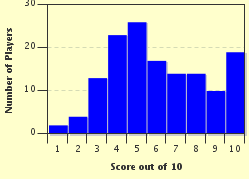Quiz Answer Key and Fun Facts
1. Who was the great hero portrayed in Sir Walter Scott's "Marmion"?
2. During "Gulliver's Travels" by Jonathan Swift (1667-1745), our hero comes upon a race of loathsome creatures who have been tamed by the virtuous Houyhnhnms. What are they called?
3. This writer was born in 1933 in Russia. During the 1960s, many of his works came under the criticism of the then Soviet government, in particular his poem "Babi Yar" (1962) tells of the extermination of 96,000 Jews in a Ukrainian ravine by Nazis during the German occupation. What is his name?
4. This Belgian born French novelist and naturalised American citizen (1903-1987) used a partially anagrammed pen name for her historical novels. She also wrote poems and plays, all with carefully researched historical accuracy. What name did she write under?
5. What was the name of the militantly anti-English group that formed in 1840s Ireland by a faction of Catholics?
6. Who is the god of the dead in Hindu mythology?
7. What was the name of the quarterly magazine of short fiction and other writings published in England between 1894 and 1897?
8. Who was the American novelist (1916-1991) who wrote 32 popular and best-selling novels, many set in the south?
9. William Faulkner (1897-1962), the American novel and short story writer, won the 1949 Nobel Prize for literature. Partial to southern tales, he created a fictitious Mississippi county where his characters came to life. What did he call it?
10. Who was the primeval giant of Scandinavian mythology whose body created the world?
Source: Author
alexis722
This quiz was reviewed by FunTrivia editor
trident before going online.
Any errors found in FunTrivia content are routinely corrected through our feedback system.

